IAC News
IAC News No.104, June 2021
Japan Society of Civil Engineers International Activities Center June 1, 2021 IAC News No.104
The 4th Seminar on the Internationalization of Technical Standards: “Internationalization of Roadside Stations”
The 4th Seminar on the Internationalization of Technical Standards: “Internationalization of Roadside Stations” was held online on March 15, 2021. Over 130 people attended the seminar by online on the day.
Roadside stations, which began with 103 stations designated in 1993, were initially designated as facilities to link regions as well as to offer rest areas and information provision facilities. In Japan, roadside stations were established as facilities to support regional stimulation, disaster mitigation, and disaster relief, and as of 2020, there are 1,180 roadside stations nationwide providing services. Given that these roadside stations are also expected to have an effect on the local economy in Asian countries other than Japan, since around the year 2000, with the financial support of international aid organizations such as the Japan Bank for International Cooperation (JBIC), Japan International Cooperation Agency (JICA), World Bank (WB), etc. technical guidance and interaction have been carried out by those who have actually been involved in the running of local roadside stations.
During the seminar, Haruo Ishida, Director General of the Research Institute for Road and Street, as part of his introduction to the third stage of the roadside station policy that will be undertaken by the Japanese government, emphasized the need for compounding of various functions expected of future roadside stations as well as branding and international expansion. Toshiyuki Monma of the Ministry of Land, Infrastructure, Transport and Tourism explained the roadside station system, the direction of future private sector involvement, the state of overseas expansion, and the public sector financial support system. This talk was followed by Fumio Kato, who has been running roadside stations for many years in Chiba, speaking about the transferring of Japan’s roadside station technologies to Vietnam and Indonesia. Mr. Kato also described his precious experience at Roadside Station Tomiura, which is regarded as a modern-day success story. To end, Kazuko Kano, who has facilitated the overseas expansion of roadside stations in Thailand and India, etc. with JBIC and JICA, talked about the important role that roadside stations have played, especially from the perspective of improving the skills of women in rural areas and their involvement in society, as well as the relationship of roadside stations with SDGs. Going forward, there are high expectations that grassroots exchanges between Japan and other countries will advance further through the concept of roadside stations developed in Japan.
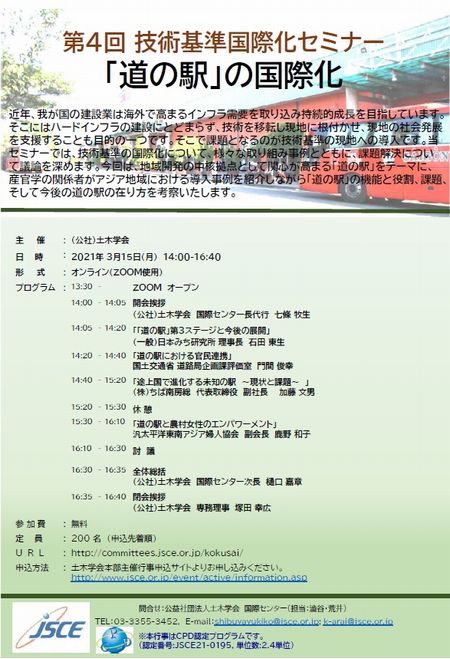
The 4th Seminar on the Internationalization of Technical Standards
【Reported by Hidenori Yoshikane(Yachiyo Engineering Co., Ltd.),
Project Group,International Activities Center, JSCE】
FY2020 Joint Seminar (Vietnam)
International Joint Seminar on Appropriate Technology in Japanese ODA’s Infrastructure Projects
Co-hosted by the Construction Management Committee of the Japan Society of Civil Engineers, the Vietnam Federation of Civil Engineering Association (VFCEA), and the University of Transport and Communications (UTC), the “International Joint Seminar on Appropriate Technology in Japanese ODA's Infrastructure Projects” was held on Thursday, March 25, 2021. While consideration was given to canceling the seminar due to the COVID-19 pandemic, both sides reached an agreement that we should definitely make the most of this opportunity and go ahead and hold the event. The other parties set up a venue at University of Transport and Communications, and it was decided that together we would hold an in-person and online “hybrid seminar” that would connect with the Japanese participants via Zoom. There were approximately 80 advanced resistrants for the joint seminar, and just over 60 people participated on the day. There were just over 30 attendees on the Vietnam side, meaning that combined attendees from both countries came to about 100 people.
This sub-committee (International Collaboration Sub-committee) has been studying the “introduction of user perspective in evaluations after official development assistance (ODA) projects.” In examining this subject, we realized the importance of examining the following two factors in order to take a closer look at this topic: [1] the differences in evaluation from the perspective of each entity (investor or user) and [2] the difference between generally adopted “standard technology” and “appropriate technology” suitable for the local conditions. Appropriate technology is defined here as technology that suits the environmental conditions that differ from country to country, such as natural conditions, construction circumstances, and maintenance capabilities. Appropriate technology in corresponding projects may differ from the “standard technology” used in Japan. In fact, various appropriate technologies have been devised and applied in Japan's ODA projects, but the lessons learned and findings of such ODA projects have not always been sufficiently analyzed, organized, and shared. That’s why this subcommittee, with Junji YOKOKURA (Yachiyo Engineering Co., Ltd.) and Hitoshi NINOMIYA (Toyo University) at the heart of proceedings, investigated case studies in which appropriate technologies were introduced in infrastructure development projects backed by Japanese ODA, analyzed and evaluated the risks associated with the selection of technologies and construction methods from the standpoints of both the donor and host countries, and conducted research to examine new technology evaluation methods.
The seminar featured six presentations, with “Fundamental Research on Evaluation Methodology of Appropriate Technology for Infrastructure Projects by Japan’s ODA (Dr. Junji YOKOKURA, Yachiyo Engineering Co., Ltd.)” and “Appropriate Technology & Global Competency (Dr. Lingling WANG, Utsunomiya University)” from the Japanese side, and “The issues of accessing ODA loan for the PPP (Public-Private Partnership) projects in Vietnam (Mr. Anh VU TUAN, Department of Infrastructure, Ministry of Transport)”, “Flood Disaster and Countermeasures in Vietnam (Associate Professor Thanh NGUYEN VIET, Transport and Communications University)”, “The issues of Special Terms for Economic Partnership (STEP) related to Japanese ODA transport projects (Mr. Tho DAO TRUONG, Thang Long Project Management Unit)”, “Some issues related to urban railway operation technology within ODA projects in Vietnam (Dr. Quy NGUYEN TIEN, Transport and Communications University)” from the Vietnamese side.
The issues discussed were roughly divided into the following two areas. The first area is appropriate technology and the second area is Japan's ODA project scheme. The first issue is the main theme of this joint seminar. The seminar participants discussed [1] evaluation items from the user's point of view, [2]a) what is appropriate technology?, [2]b) how to apply appropriate technology?, and [3] (= [1] + [2]) the evaluation of appropriate technology from the user's point of view. Many questions and opinions were raised from the Vietnamese side as well as from Vietnamese engineers working for consulting firms in Japan. The Vietnam side also made a proposal to carry out joint research because “appropriate technology” is important. Regarding the second issue, there were some requests from the Vietnamese side, including that of “STEP”, and it was observed that there was a difference in understanding between the Japanese side and the Vietnamese side. From the Japanese side, the difference in understanding could be put down to the fact that there is at the very least [1] a difference in the perception of risks and [2] a difference in the perception of what the goal is. It was observed that for [1], it is possible to achieve a win-win situation by integrating the perceptions of both parties, but that business-like negotiations and compromises would be required for [2]. I felt that it is important to continue this kind of open exchange of opinions in the future.
Through this joint seminar, we were able to deepen discussions about the essence of appropriate technology and improvements to evaluation methods after projects, and this opened the door for facilitating joint research in the future. The proceedings of this seminar will also be published in May 2021. The outcome of this seminar is expected to contribute to academic value in the form of developing appropriate evaluation methods for selected technologies in ODA social infrastructure development projects, as well as practical value in the form of improving the effectiveness and efficiency of evaluating Japan's ODA social infrastructure development projects.
We received help from many people in holding this seminar. In particular, I would like to express a heartfelt thanks to Dr. Hai NGUYEN LUONG, an associate professor at University of Transport and Communications, who served as the secretary-general for this seminar, as well as to the secretariat of the Japan Society of Civil Engineers.
※This joint seminar is supported by International Scientific Exchange Fund, JSCE.
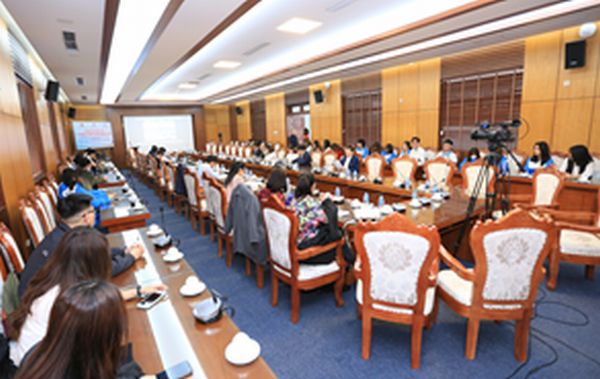
Seminar is Connected to UTC
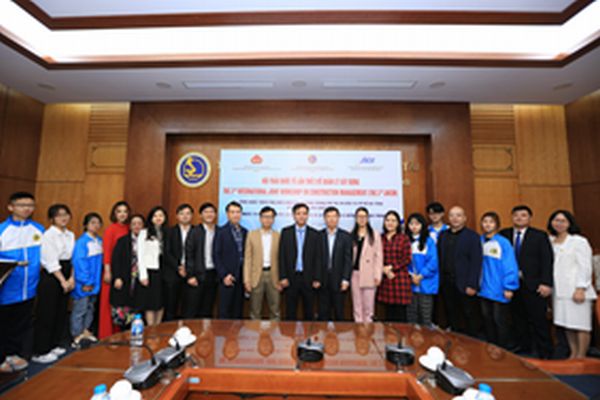
Participants on the Vietnam Side
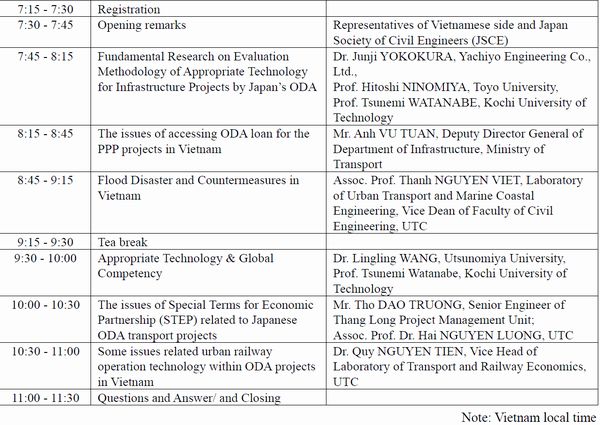
【Reported by Tsunemi Watanabe, Former Chair, International Collaboration Sub-committee,
Construction Management Committee (Kochi University of Technology) 】
Joint Japan-US Symposium on
Assessment, Management, and Governance for Infrastructure Resilience
The symposium “Joint Japan-US Symposium on Assessment, Management, and Governance for Infrastructure Resilience” was held online for the four days of April 14 (Wednesday), April 16 (Friday), April 28 (Wednesday), and April 30 (Friday) with the cooperation of the Japan Society of Civil Engineers and the American Society of Civil Engineers Infrastructure Resilience Division (ASCE IRD). The first symposium was entitled “Symposium on Infrastructure Resilience”, with researchers and practitioners from both academic societies gathering at the Civil Engineering Hall on May 22 and 23, 2019 to introduce the concept of an infrastructure resilience framework and discuss the importance of infrastructure resilience. Since then, both academic societies have continued joint research to promote awareness of the framework and apply it in practice as well as draw up related manuals.
At this symposium, the concept of the framework was reiterated and discussions from a variety of different perspectives took place about how important it is that we strengthen and improve resilience in order to ensure we mitigate the risk of natural disasters that have increased significantly in scale in recent years and ensure the survival, development, and well-being of our community.
The first session (April 14) welcomed Kiyoshi Kobayashi, a distinguished professor (Kyoto University, the 106th President of the Japan Society of Civil Engineers), and two other keynote speakers. Explaining the concept of infrastructure resilience framework and the importance of community resilience, he spoke about methodologies for analyzing, designing, and improving resilience. In the second session (April 16), Professor Yoshikazu Takahashi (Kyoto University), Sho Asada (Water and Disaster Management Bureau of the Ministry of Land, Infrastructure, Transport and Tourism), and two other keynote speakers were invited to discuss community functions, management, and governance, and they considered the resilience of social infrastructure facilities. In the third session (April 28), Professor Riki Honda (The University of Tokyo), Professor Yoshio Kajitani (Kagawa University), and two other keynote speakers discussed aspects of infrastructure such as disaster mitigation, disaster recovery and restoration, economic activities, and transportation and telecommunications regarding their relationship with resilience and the community through the operation and management of infrastructure systems. The fourth session (April 30) summarized the discussions over the previous three days and discussed an integrated approach to improving community resilience as well as new initiatives and policies.
Strengthening and improving the resilience of infrastructure to ensure the well-being of the community is a constant issue and challenge for civil engineers. The Japan Society of Civil Engineers and ASCE IRD will address to work on issues and consider new approaches and technologies.
You can watch the videos of presentations at the symposium as well as live recordings of the discussions (https://www.infraresil.jp/event/01/). Be sure to check them out.
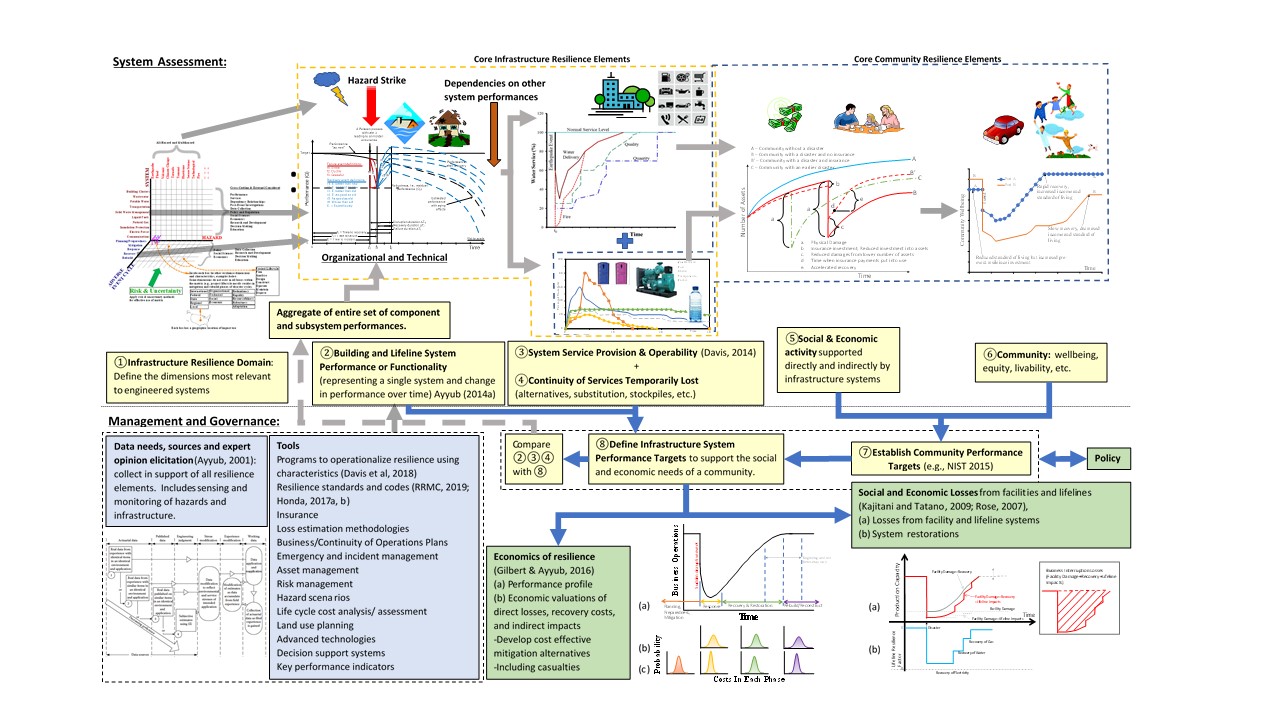
Infrastructure Resilience Framework
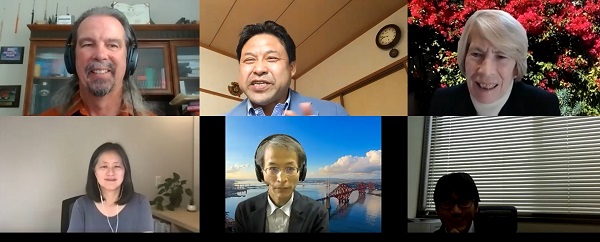
Panelists and MC of Day 3
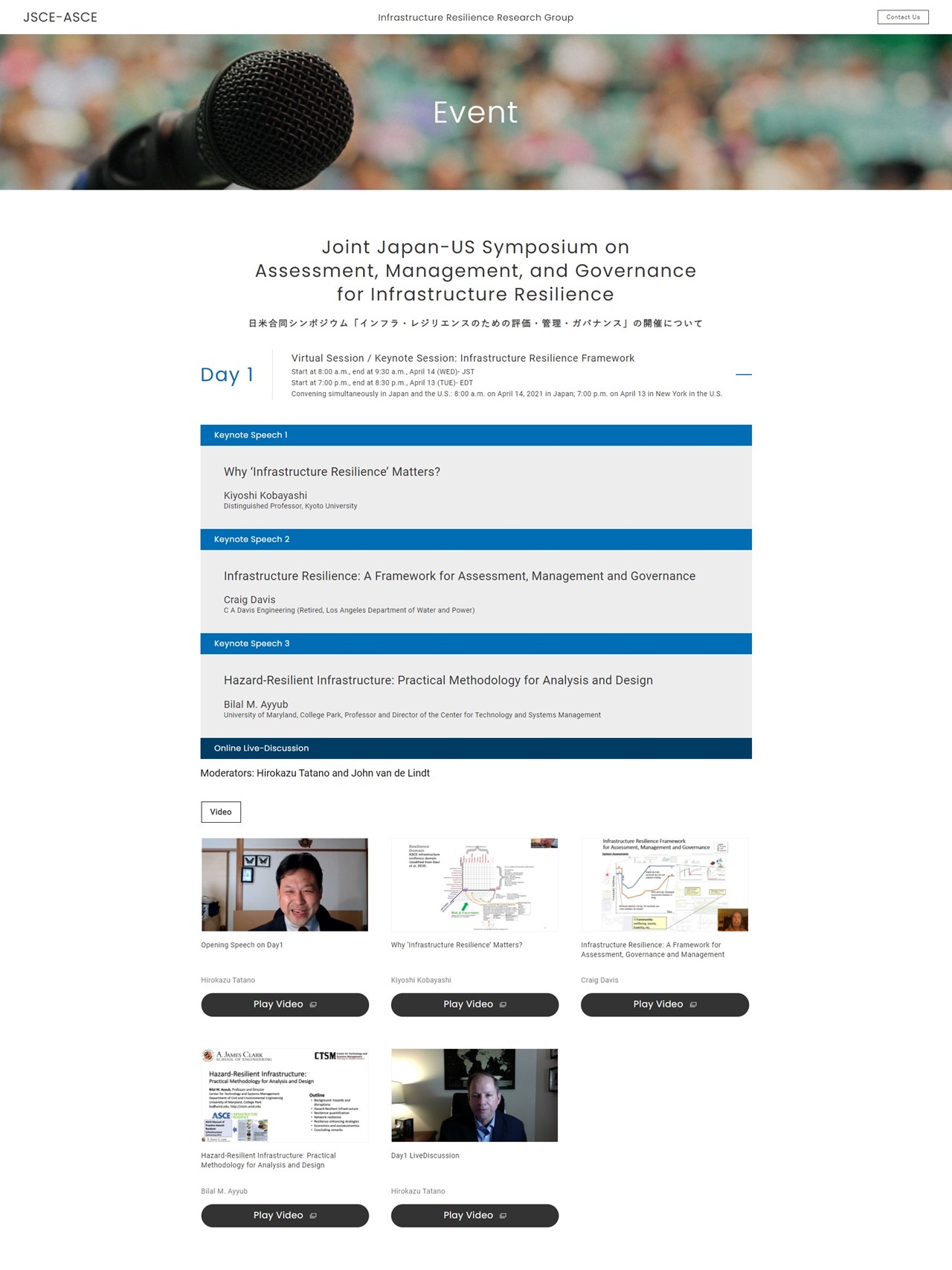
Pre-recorded Presentation Videos Available on the Website
【Reported by JSCE-ASCE Infrastructure Resilience Research Group】
Updates
- Seventh Engineers' Lounge “DOBOKU” (Japanese)
https://committees.jsce.or.jp/kokusai/node/222 - Joint Japan-US Symposium on Assessment, Management, and Governance for Infrastructure Resilience
*Pre-recorded Presentation Available on the Website.
https://www.infraresil.jp/event/01/ - Neak Loeung Bridge (Tsubasa Bridge) Construction Project
http://www.jsce.or.jp/e/archive/project/pj12.html - The International Infrastructure Archives
– A Compilation of Japan’s Greatest Projects in Transfer of Civil Engineering Technology in Service –
http://www.jsce.or.jp/e/archive/ - ASCE Lifeline Conference 2021 2022
Transportation Sector panel discussion, June 10, 12p.m. (PST)
https://samueli.ucla.edu/lifelines2021/ - The 17th World Conference on Earthquake Engineering (17WCEE)
http://www.17wcee.jp/index.html - IAC YouTube Channel
https://ec-intl.co.jp/evaces2021/ - 9th International Conference on Experimental Vibration Analysis for Civil Engineering Structures (EVACES2021)
https://ec-intl.co.jp/evaces2021/ - IAC “News Pick Up!!” on the JSCE Japanese website
https://committees.jsce.or.jp/kokusai/iac_dayori_2021 - Summary of featured articles in JSCE Magazine Vol. 106, No.6, June 2021
http://www.jsce-int.org/pub/magazine - Journal of JSCE
https://www.jstage.jst.go.jp/browse/journalofjsce
IAC News Subscription
The IAC News is one of the communication tools to share information and ideas with the members. We would like to invite you, your friends and colleagues to join the communication and to subscribe the IAC News. Please register online: (http://www.jsce-int.org/node/150). We look forward to meeting you.
